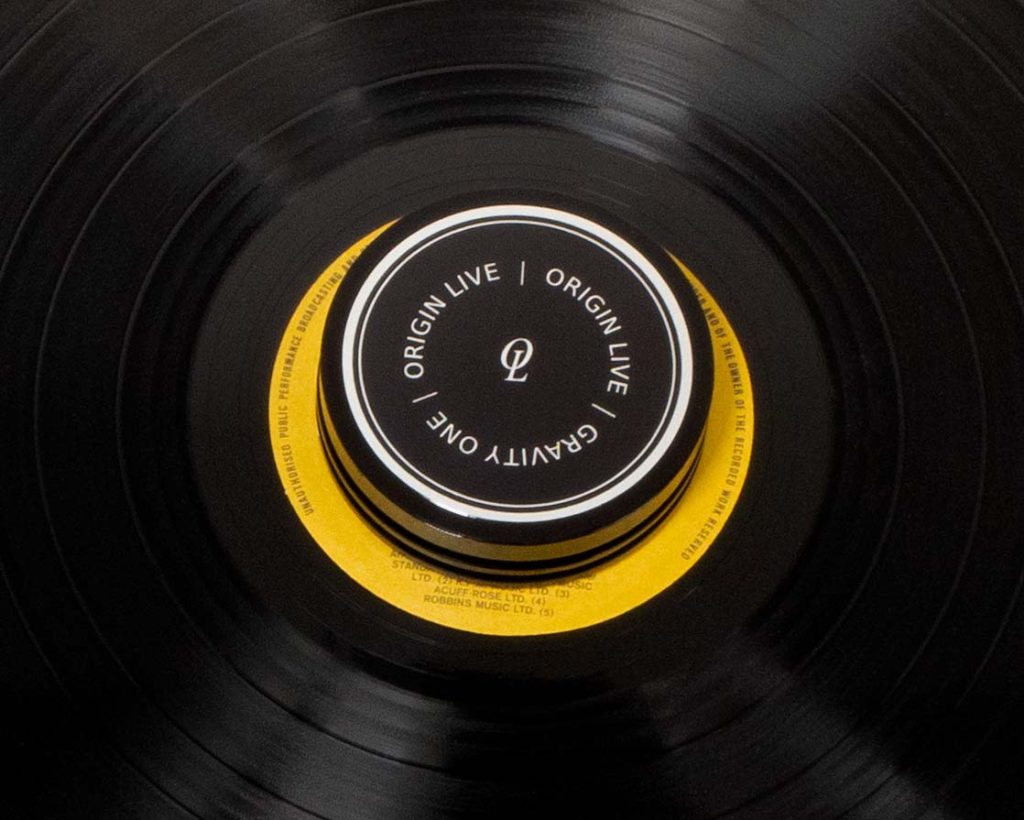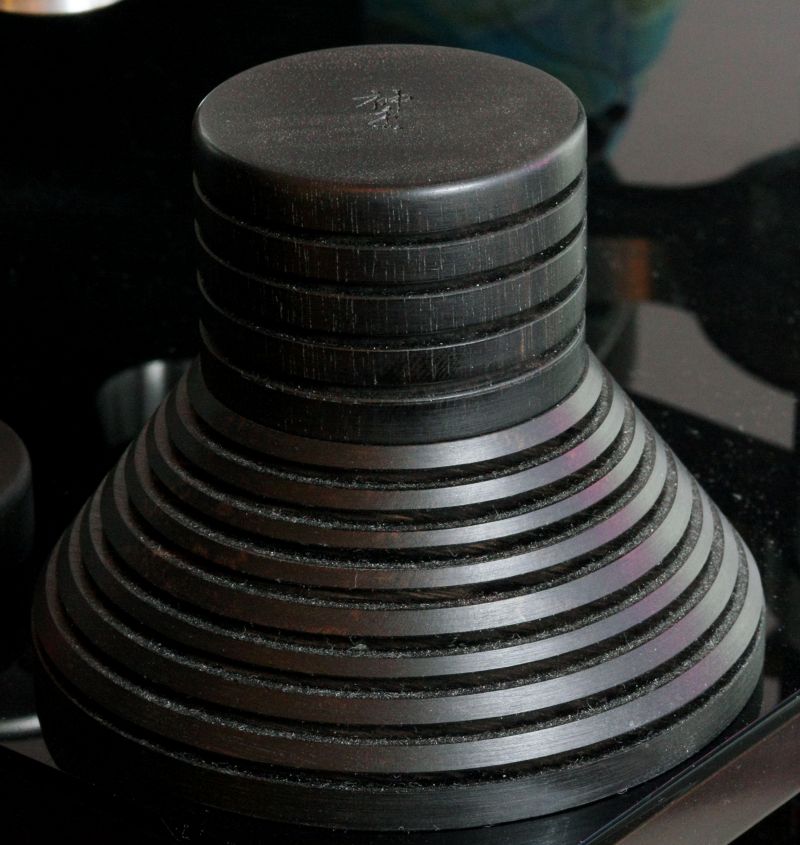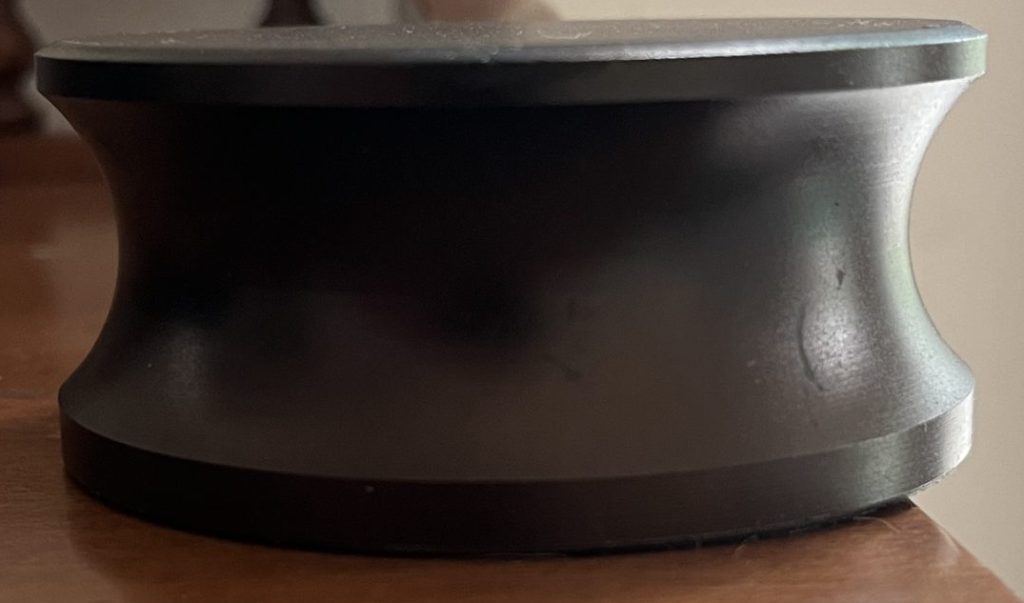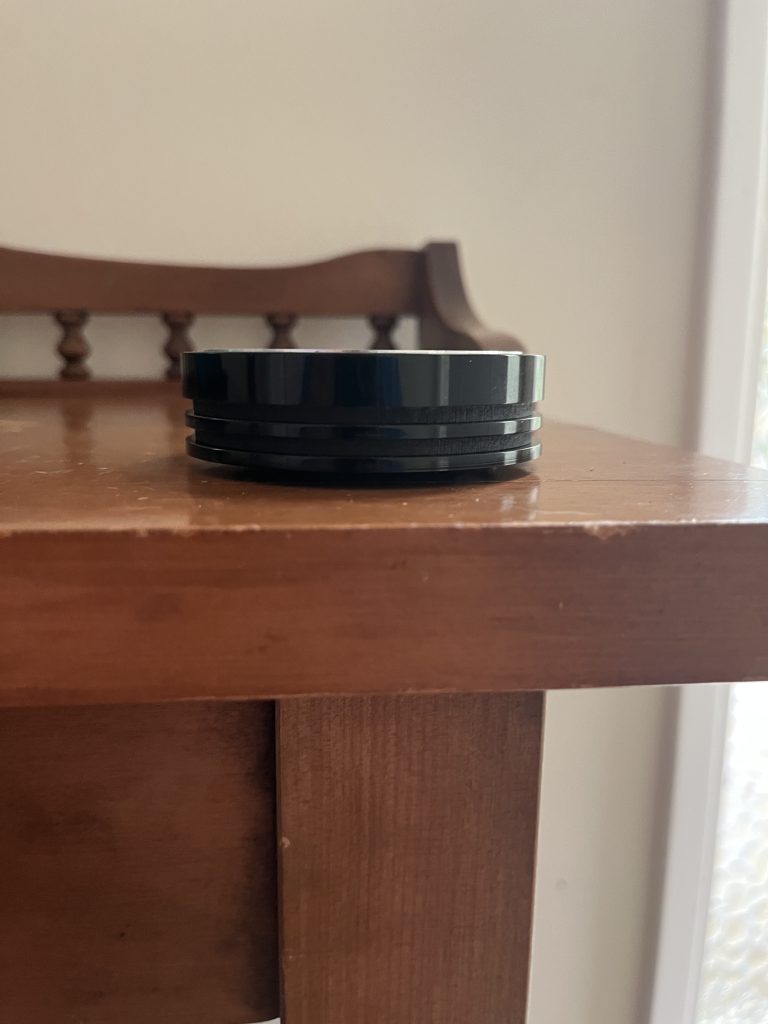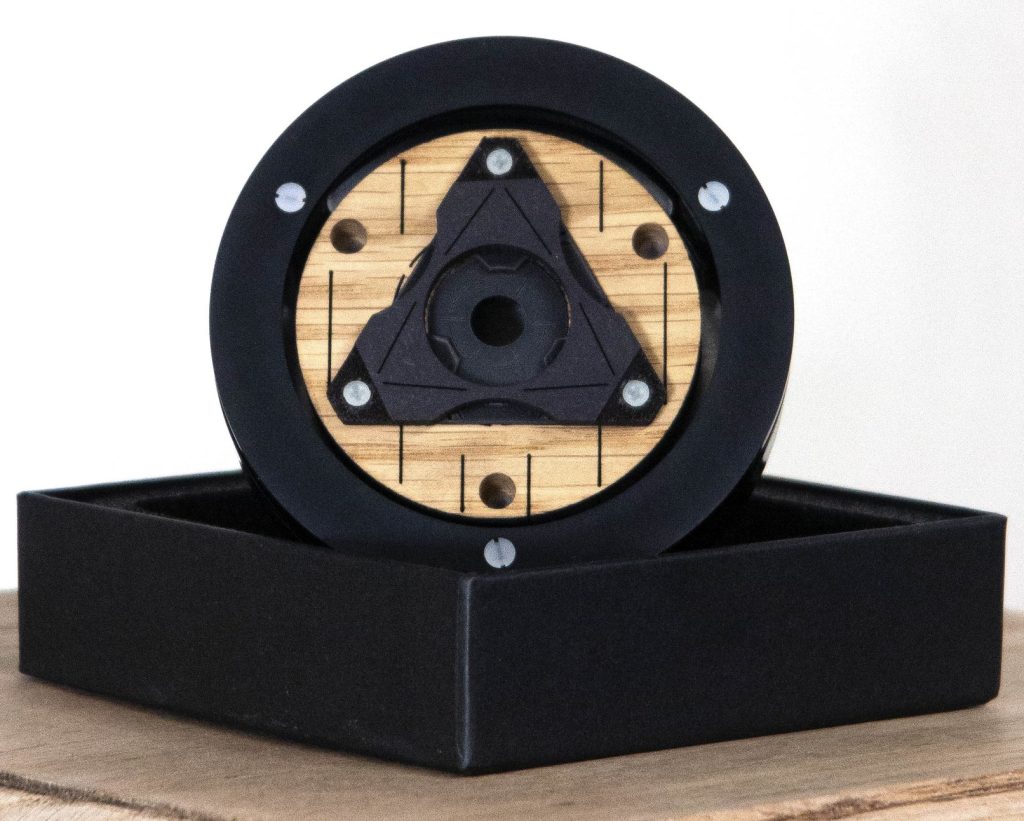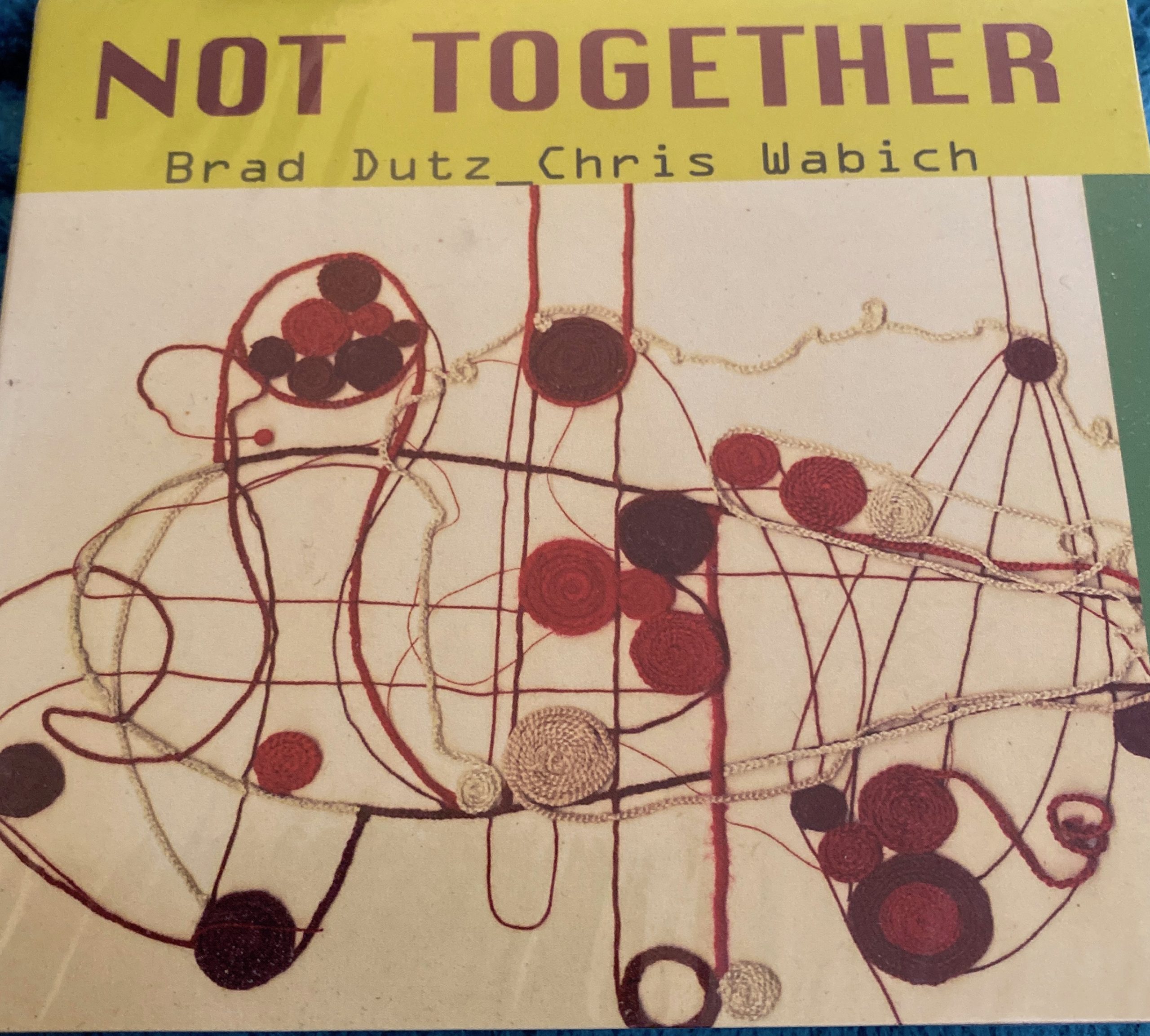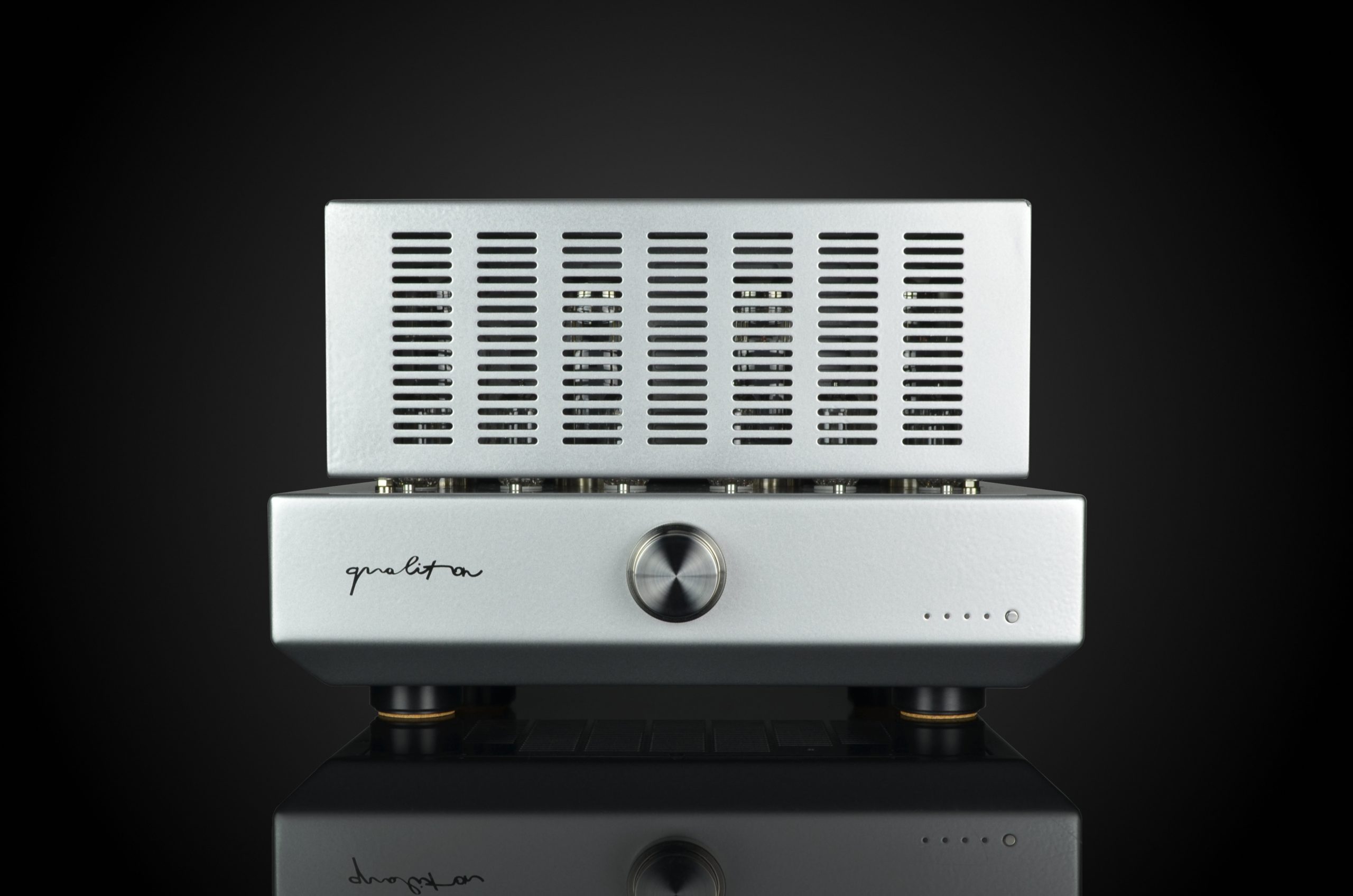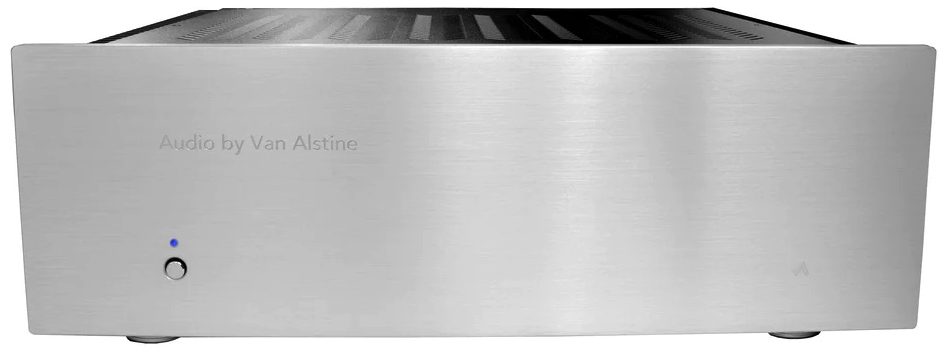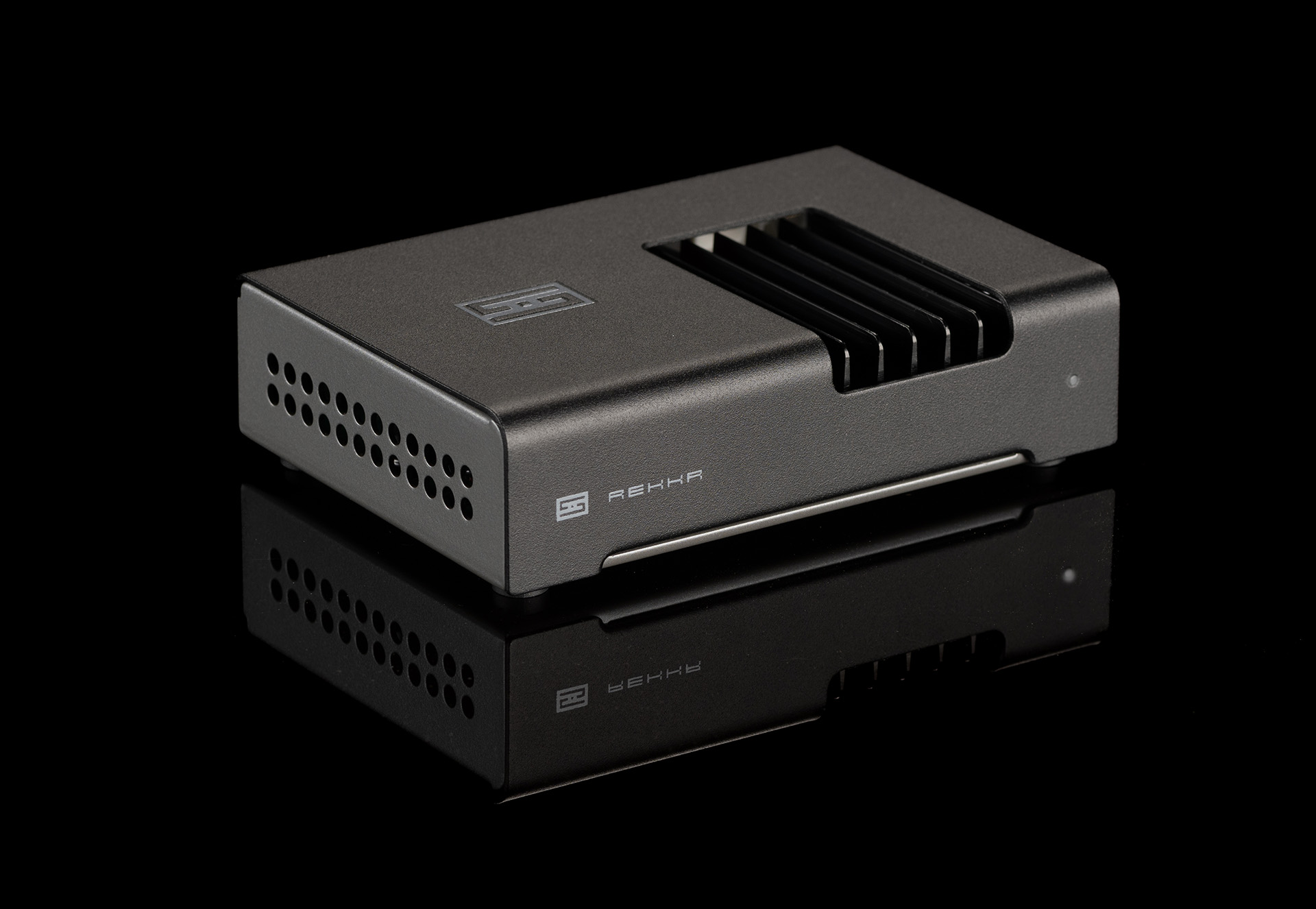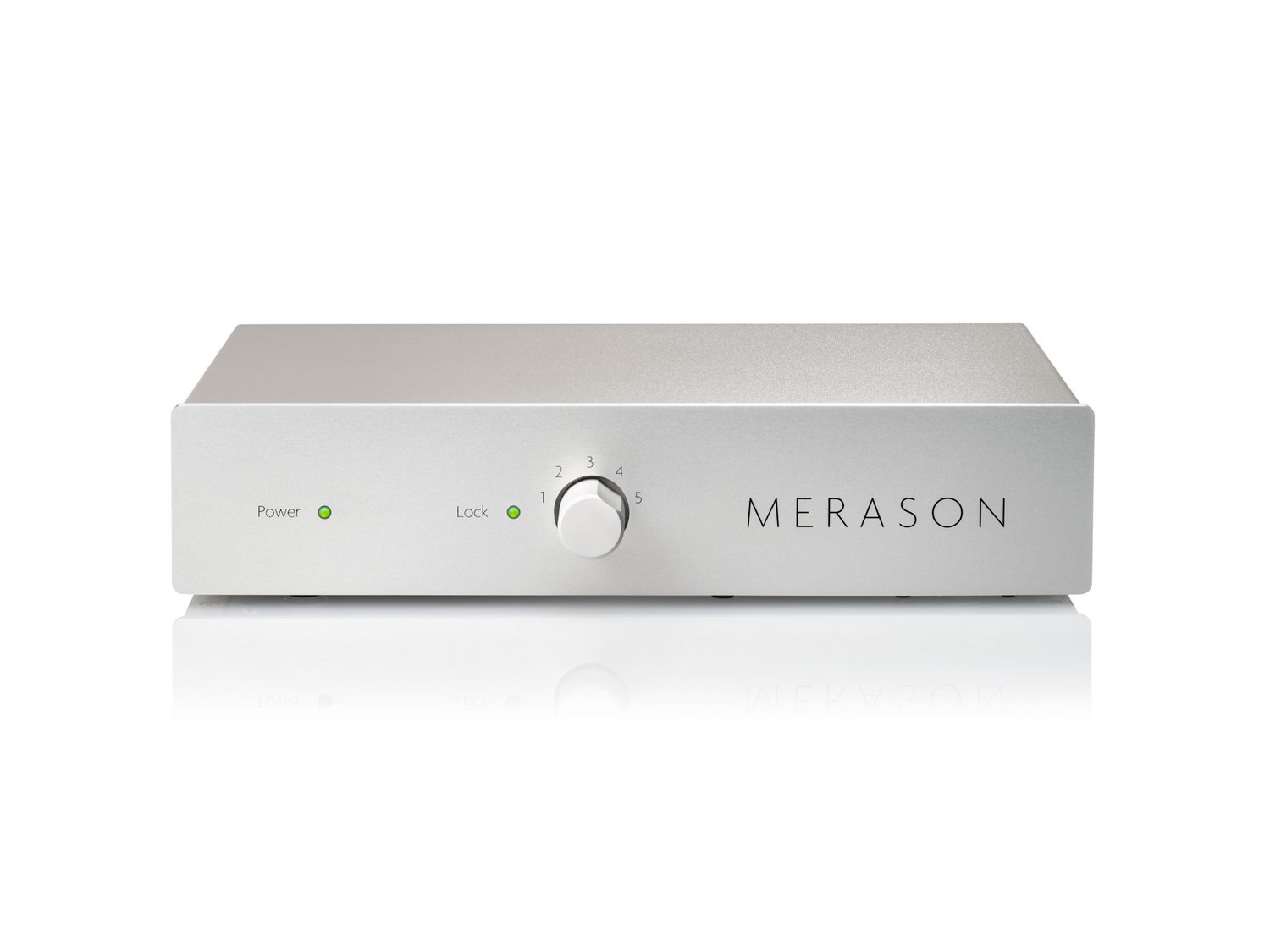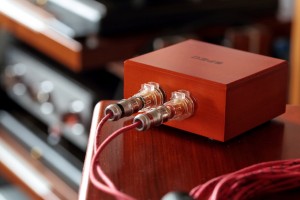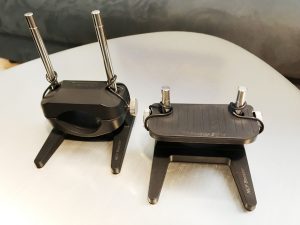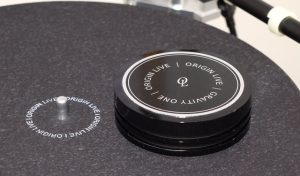Image courtesy of Origin Live
Audiophiles include people from a smattering of all spectra on the human scale, from the rigorously scientific—show me the data—to those who rely simply on their own experience, and those who take in others' opinions as their own. I'm largely in the second category but occasionally find myself in the others. A striking example of the last is the folklore that arose around some Shun Mook products, in particular their LP Clamp. It is, and was, a milled piece of ebony root—not just ebony—that was placed atop the record label of an LP. It was said to really improve playback. Many have heard of it, but far fewer have heard it. I expect its efficacy relies on a serendipitous resonant quality and perhaps the wood's machining. In 2021 it sold for $3200 at The Cable Company, though a second hand sample sold for $4200. Ouch!
Image courtesy of Shun Mook
I had heard that Shun Mook's Mpingo Discs, made of ebony, were impressive and surprisingly made a difference. I was present for a dealer demonstration of the Mpingo Discs, but heard no alteration of sound. Hmm, you and I say. I heard Shun Mook's Bella Voce Reference speaker and was very impressed, as in, I was very impressed. Would Shun Mook's LP Clamp make a difference to me?
Mark Baker, founder of Origin Live, heard similar stories about that LP Clamp. Unlike me, he got to hear it in action. The surprise here is that apparently the clamp made such a difference that Baker was inspired to capture some of what he heard with his LP "Gravity Weight."
So, who or what is Origin Live (OL)? OL is a British company founded by Mark Baker in the 1980s, originally as a cable manufacturer. The company evolved to start building turntables and then tone arms. It seems the focus of their efforts are now exclusively in the vinyl realm, though they offer no phono stages.1 They have a healthy stable of tables and arms; the former start at £1590 and go to £47,000; the tonearms start at £480 and go to £26,000. Ouch! When paired together their turntables and tone arms are often praised as over achievers.
I have no experience with either their arms or tables in my system. However, an audiophile friend with renown in this industry for putting on a good show, and whom I know to be very discriminating, liked their tables and arms. Praise escapes his lips only occasionally, so his praise of Origin Live products occurs as very high praise to me. Previously, I've stolen from this friend's experience to get what I consider a satisfying analog setup. So, what about OL's record weight?
The Gravity Weight retails in England for £195, or about $250 in the US, give or take based on exchange rates. For starters, the naming scheme could be misleading. Note, it's not called a clamp because there is no clamping going on. To call attention to its weight suggests there is a considerable amount; there isn't. The Gravity Weight weighs a mere 2.4 ounces. Like Shun Mook's LP Weight, the Gravity Weight lies on top of the LP label. Clearly not much clamping going on.
Image by Larry Cox
I've had a record weight I bought on an impulse ten years ago. Made of turned aluminum with a felt bottom, its technology is mass, not sophisticated design. Does it work? I have used it regularly since my purchase. It seems to quiet thin records that I think sound a bit bright and or lean. It seems to work primarily in the upper midrange and treble regions. It does not work on every record. To be honest, I liked it enough to not suss out its performance profile, i.e. what sonic elements does it address?
What it does not address, that I believe no record weight placed on top of the label does, is flattening a warped record. To make an LP flat, versus providing some flattening, requires a lot of weight. The best location for flattening the periphery of an LP is a peripheral weight. Significant weight over a label is likely to impact the bearing underneath it, which no doubt creates more friction on the spinning bearing and is distinctly unlikely to flatten anything but your wallet. This is definitely not a clamp.
In part my laziness in sussing out my record weight is because it provides neither a dramatic improvement nor does it cause a dramatic loss of sound quality. At this point, I'd say it is part audio tweak and part religious talisman accomplishing immeasurable things in the spirit world, or my mind, rather than on my turntable. My twenty-five dollar investment weighs 14.2 ounces and, well, I use it because I have it. As something paid for, I'm going to get my money's worth. With this review, I'm going to dip my toe in to sussing out whether it works on records or just my mind. Back to the Gravity Weight.
Well, we'll get to the Gravity Weight, soon enough. I initiated this assignment because it seemed like a really easy comparison. Damping vibrations is a ubiquitous concern in audio. It's usually accomplished by using enough weight to damp vibrations. That's what my "reference" relies on. Does mere weight damp vibrations without penalty? Perhaps more sophisticated engineering can address the issues better with less weight?
The Gravity Weight does not rely on mass and serendipitous resonant qualities, as I see it. Origin Live does not explain how the Gravity Weight works. Unfortunately for you, you'll be stuck with my probably flawed analysis—my background in physics is quite limited—a college class derided by science majors as "Physics for Poets," so, get your salt shaker ready.
Image by Larry Cox
A Description
Looking from the side, the Gravity Weight is a solid piece of a hard plastic material in the form of a shell. That "shell" part does not actually touch the LP, instead the shell is simply housing for the materials that do the work. Turn the "shell" over and you'll see a triangular bit of plastic, the three corners of which are affixed by brass screws into a piece of wood. The triangular plastic is scored again inside the screws, though it does not seem to create a separate piece of plastic. That triangular piece is then affixed by three screws to a circular piece of wood. The wood seems to be secured, loosely, to the shell. (Only the holes for the screws are visible in the picture) 2
Image Courtesy of Origin Live
It appears that the shell houses the wood/triangle so as to damp vibrations. All screws, Origin Live says, are brass. Brass has mercurial magnetic qualities, based on the proportions of zinc and copper—removed from external magnetic forces, it loses its magnetic qualities. So, maybe the screws, if the proportions are high enough in zinc, won't store magnetic properties and perhaps that also reduces a capacity to store static electricity. Interestingly, when tapped individually, the outer shell, outer part of the triangle, the inner part of the triangle and the wood all resonate at slightly different frequencies. Is this tuning?
In Action
My testing method here was to play the outside (1st) track of several LPs, first with no weight, then my "reference" weight and finally the Gravity Weight. I selected the first track because it is likely to have the greatest warp and thus produce the most noise. I placed a series of records on my Amazon Model 2 turntable, first with a Moerch DP6 yellow wand tonearm with a Dynavector XX2MkII cartridge. Part way through this experiment, I switched from the Moerch to a Fidelity Research FR54 tonearm with a Shure M95EDM cartridge and then the Dynavector again but on the FR54. The results of the different arms and cartridges yielded the same essential results.
No Weight
The big picture synopsis to start with is that without a weight there was a bit more high frequency hash, which initially occurred as "air" and "detail." This impression held whether the LP was "standard issue" from its original publication, or a remastered 180g LP. It did not seem to matter the genre or instruments replayed. This held whether there was more high frequency information or not.
As I listened closer to the "no weight" sound, after using the other two devices, I heard the high frequency hash whether the record was thick or thin. This sound could be a bit brighter sounding or it could also be characterized as more "airy" or open sounding. Imaging seemed more alive or just lively. On "dead sounding" LPs that could be welcome—keep in mind LPs were the referent for CDs to be touted as perfect sound forever. The same album in iterations further away from the original "mother" disc may sound quite different. Nailing sound down to a specific conclusion isn't possible, there are too many variables. Let's say, no weight could be great or not so much.
Reference Weight
My weight damped the top end, making records more midrange centric, with the bottom end unaffected. Consider my record weight a slightly more rolled off presentation; actually I'll call it a more damped presentation. Sounds were clearer, but also truncated tone and dynamics from the upper midrange into the treble regions. Sustains were distinctly truncated. Depending on the recording my preference between the two varied. My copy of 10cc's The Original Soundtrack needed more high frequency damping, especially on "Une Nuit A Paris : Later The Same Night in Paris." So there is a limit to how much damping occurs even when it is sometimes too much.
Sometimes damping the midrange up into the treble served for more musical engagement and sometimes I missed that extension and was willing to accept the squashed dynamics the weight imposed. My default preference would be for a more damped presentation than one salted with hash.
With music that relied on richness and midrange musical timbre for its pleasure tipped me to preferring my weight because that made tone and timbre a bit more inky. This type of music would be larger scale classical music or music with a dominant piano component. Music that featured stringed acoustic music, well that higher frequency "air" sounded more like a real event without my record weight. But this explanation or conclusion implies a greater clarity of preference than I actually had prior. At the end of this experiment, my head spins anticipating whether I'd know before I heard a particular recording whether I'd want my weight nor not.
Gravity Weight
Now we come to the unfortunate case of the Origin Live Gravity Weight. Well, unfortunate for me. I liked it very much and preferred it to no weight or my hunk of metal. And I preferred it on all types of music, whether a lighter balanced stringed acoustic instruments or richer genres filled with piano and instruments with a lower register. Although some elements of sound changed, it largely delivered the same music in roughly the same way, but with enough reduction in noise to make music more "real" and pleasurable.
Although it's not an important part of my musical preferences, the element that was most easily identified as "improved" was imaging. My weight created a solidity coupled to an unwelcome heaviness that made the impression of music more leaden, less human, and simply less enjoyable. The way instruments were portrayed was more lithe and alive than the same music with my weight. It seems the more precise music is reproduced, the less alive it is. The Gravity Weight did not create greater precision, but it did allow for greater clarity that kept my music alive.
My weight definitely put a thumb on the scale of my music, making it all a certain way. While I initially liked how it damped hash in the treble, I could not listen past how it damped the midrange performance, especially on piano. The damping became like body odor on a nice person, at some point it's harder to look/listen past the offending quality.
I value what gear does to make the music I own and want to listen to sound good or really be enjoyable. Some music never sounded good but is fun, for example the delightful absurdity of 10cc's album The Original Soundtrack. Featuring songs like "Life is a Minestrone" with lyrics like "life is a minestrone, served up with parmesan cheese." My copy is a terrible pressing, but it doesn't stop me from enjoying it.
Neither the Gravity Weight nor my weight could cure the hashy qualities of this pressing. Where my weight weighed down (I had to say that at some point, right?) the aliveness, Origin Live's device preserved the essential qualities that no weight did while making it slightly more listenable from an audiophile perspective. The most recognizable song on this album "I'm Not in Love" has a richer, less hashy quality that OL's device did not wreaking havoc on the midrange.
The Gravity Weight was definitely better than no weight, and my five times heavier bit of aluminum. At $250, I didn't want this "tweak" to work, but in my system with my music collection and preferences it clearly increased my sense of live music in a real acoustic space.
My primary interest in the Gravity Weight was how it would work with my spring loaded (suspended) Thorens TD125. More weight on top of that bearing is much more important to me. Unfortunately, the Thorens developed a massive hum, the location of which I've not been able to identify, as I write. I'll update this note soon, hopefully.
Parting Thoughts
The Gravity Weight is not lipstick or make up. It won't change the fundamental profile of your system. I think it helped me get a clearer sense of how my system was performing. And, I liked that. At the start of this review I was uncertain whether I'd want my weight or no weight on a particular recording, at the end of this review, I always reached for the Gravity Weight.
1 I somehow missed that Origin Live is now selling two phono stages, which I also have not heard! My apologies.
2 Origin Live provided a correction to my description with the following language : "the triangular piece is not actually plastic, it is a composite layer resting on top of another composite layer resting on the wood."
Origin Live Gravity Weight
Retail: £195 / approximately $250
Origin Live
+44 (2380) 578 877
Unit 5 362B Spring Road, Southampton
Hampshire, SO19 2PB UK




